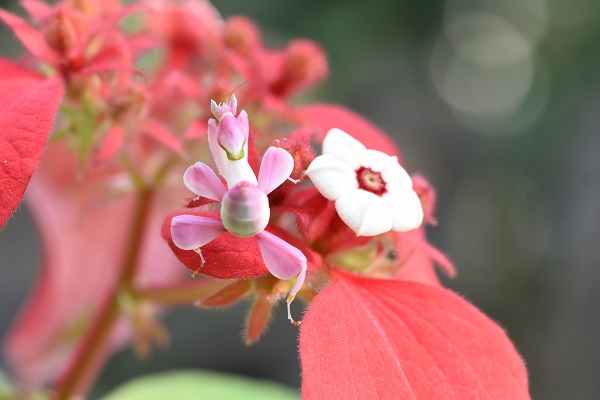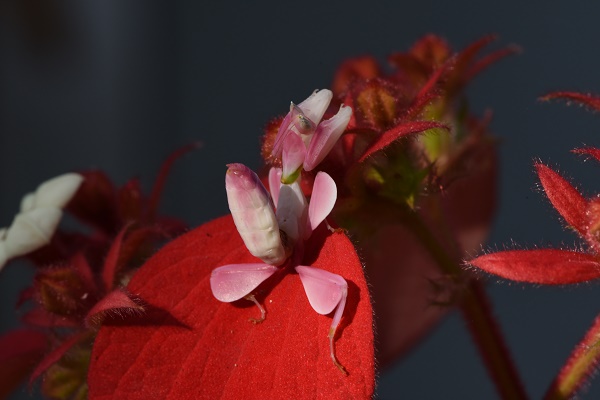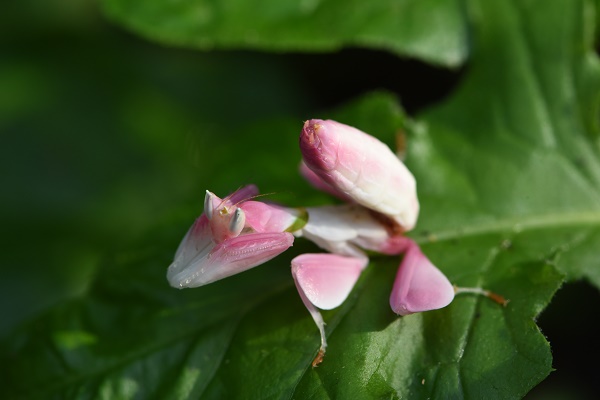In a study published in Current Biology, researchers from the Xishuangbanna Tropical Botanical Garden (XTBG) of the Chinese Academy of Sciences, together with their collaborators, revealed a groundbreaking discovery: Morphology of the orchid mantis’s petal-shaped femoral lobes actually serves as structures for gliding, rather than the long-held belief that these lobes mimic flowers to attract pollinating prey.
The orchid mantis Hymenopus coronatus is an arboreal species long hailed as a classic example of flower mimicry because of its petal-shaped femoral lobes and flower-assemble body surface coloration. This interpretation has persisted for over 200 years, although empirical evidence for the petal mimicry function of these lobes remained inconclusive.
In this study, the scientists conducted behavioral research as well as morphological analyses. They first tested whether orchid mantis nymphs could glide and found that orchid mantis nymphs are excellent gliders, exhibiting the shallowest gliding trajectories observed in terrestrial invertebrates.
Upon observing the nymphs’ aerial escape initiated by active jumping, the researchers proposed that the femoral lobes play a crucial role in gliding. Subsequent studies under controlled conditions confirmed that these lobes contribute to lift generation during descent, significantly influencing the mantis nymphs’ gliding ability.
Morphological examination of the orchid mantis’ femora revealed that the lobe extensions on their femoral segments are cambered airfoils, increasing the projected area by 36%. This feature plays a vital role in making the observed gliding aerodynamically possible.
Furthermore, despite a dramatic 165-fold increase in the females’ body mass and a 24-fold increase in males’, the growth in body size did not compromise gliding, a phenomenon attributed to the enlargement of the femoral lobes.
The researchers also highlighted a remarkable 40%–56% reduction in wing loading as a result of the positive size allometry of these lobes, indicating a clear promotion of gliding throughout orchid mantis development. In fact, expansion of femoral lobes throughout ontogeny reduced wing loading and improved gliding efficiency.
“These lobes represent the first documented rigid exoskeleton structures enabling gliding, making orchid mantises the most adept arthropod gliders known to date,” said CHEN Zhanqi of XTBG.
The study provides insights into the purpose of gliding in orchid mantises. “They are likely subject to the same selective pressure for aerial escape and dispersal as other arboreal invertebrates and may also rely on gliding to access hunting territories,” said CHEN Zhanqi.
This is the first study to document an arthropod leg wing used for gliding and suggests future studies of three-dimensional glide trajectories in orchid mantises to reveal mid-air maneuvers.
Contact
CHEN Zhanqi Ph.D Principal Investigator
Key Laboratory of Tropical Forest Ecology, Xishuangbanna Tropical Botanical Garden, Chinese Academy of Sciences, Mengla, Yunnan 666303, China
E-mail: chenzhanqi@xtbg.ac.cn
Published: 29 November 2023

Orchid mantis. (Image by ZHAO Xin)

Orchid mantis. (Image by ZHAO Xin)

Orchid mantis. (Image by CHEN Zhanqi)

Orchid mantis. (Image by CHEN Zhanqi)




